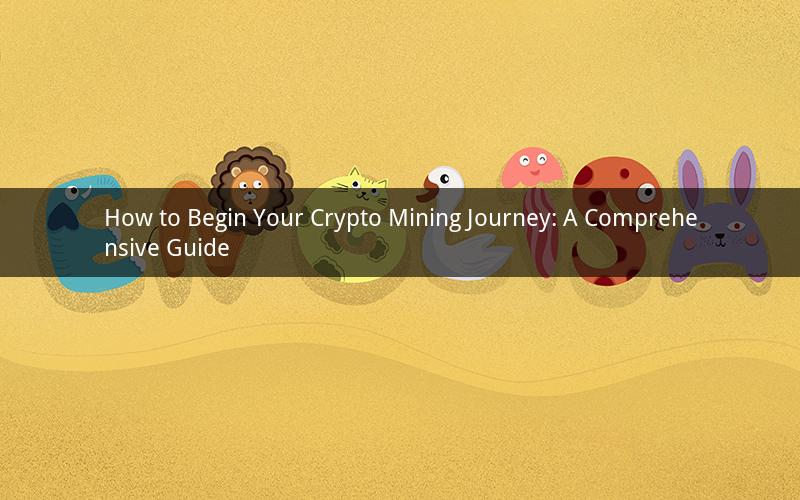
Crypto mining has emerged as a popular and lucrative venture in the world of cryptocurrencies. With the increasing demand for digital currencies, many individuals are looking to get involved in mining. However, the process can be daunting for beginners. In this article, we will delve into the steps involved in starting your crypto mining journey, from selecting the right hardware to setting up your mining rig and joining a mining pool.
1. Understand the Basics of Crypto Mining
Before diving into the technical aspects of mining, it's essential to understand what crypto mining entails. Crypto mining is the process of validating and adding new transactions to a blockchain, which is the public ledger of all transactions in a cryptocurrency network. Miners use their computing power to solve complex mathematical puzzles, and in return, they are rewarded with cryptocurrency.
2. Choose the Right Crypto to Mine
Not all cryptocurrencies are suitable for mining. Some cryptocurrencies have high mining difficulty levels, which require more powerful hardware and consume more electricity. Additionally, some cryptocurrencies may have reached their maximum supply, making it impossible to mine new coins. Research different cryptocurrencies, considering factors such as market capitalization, mining difficulty, and potential profitability, before deciding which crypto to mine.
3. Select a Suitable Mining Rig
A mining rig is a specialized computer designed for mining cryptocurrencies. The most important components of a mining rig are the graphics processing units (GPUs) or application-specific integrated circuits (ASICs). GPUs are generally more cost-effective and versatile, while ASICs are more powerful and efficient for specific cryptocurrencies.
When choosing a mining rig, consider the following factors:
- Compatibility: Ensure that the GPU or ASIC is compatible with your mining rig's motherboard and power supply.
- Power Consumption: Minimize power consumption to reduce electricity costs.
- Cooling: A well-ventilated mining rig can prevent overheating and extend the lifespan of your hardware.
- Price: Balance the cost of the mining rig with its potential profitability.
4. Set Up Your Mining Rig
Once you have selected the right hardware, it's time to set up your mining rig. Follow these steps:
- Assemble the mining rig according to the manufacturer's instructions.
- Install the necessary drivers and software.
- Connect the mining rig to a power source and internet connection.
- Boot up the mining rig and ensure it's functioning correctly.
5. Join a Mining Pool
Mining pools are groups of miners who work together to increase their chances of earning rewards. When you join a mining pool, you are pooling your computing power with other miners, which allows you to earn rewards more frequently. To join a mining pool, follow these steps:
- Research and select a reputable mining pool.
- Create an account on the mining pool's website.
- Install the mining pool's software on your mining rig.
- Configure the software to connect to the mining pool.
6. Monitor Your Mining Rig
Monitoring your mining rig is crucial to ensure optimal performance and profitability. Use mining software to track your rig's performance, including the hash rate, temperature, and power consumption. Additionally, stay informed about market conditions and adjust your mining strategy accordingly.
7. Keep Up with Security and Maintenance
Maintaining your mining rig's security and performance is essential to prevent hardware failures and data breaches. Follow these tips:
- Regularly update your operating system and mining software.
- Use a strong password for your mining rig and pool account.
- Implement security measures such as firewalls and antivirus software.
- Clean your mining rig's fans and cooling system to prevent dust buildup.
Common Questions and Answers
1. Q: What is the difference between GPU mining and ASIC mining?
A: GPU mining uses graphics processing units to mine cryptocurrencies, while ASIC mining uses application-specific integrated circuits. GPUs are more versatile and cost-effective, while ASICs are more powerful and efficient for specific cryptocurrencies.
2. Q: How much does it cost to start mining crypto?
A: The cost of starting a crypto mining operation varies depending on the hardware and electricity costs. A basic setup with a few GPUs can cost a few hundred dollars, while a high-end setup with multiple ASICs can cost tens of thousands of dollars.
3. Q: Can I mine crypto with a regular computer?
A: While it's possible to mine crypto with a regular computer, it is highly inefficient and likely to result in low profits. A dedicated mining rig with powerful GPUs or ASICs is recommended for optimal performance.
4. Q: How do I calculate the profitability of my mining operation?
A: You can use mining profitability calculators available online to estimate the potential profitability of your mining operation. These calculators consider factors such as the cost of electricity, hardware, and mining difficulty.
5. Q: Can I mine multiple cryptocurrencies with the same rig?
A: Yes, you can mine multiple cryptocurrencies with the same rig. However, some cryptocurrencies require different mining algorithms, so you may need to switch your mining rig's configuration accordingly.